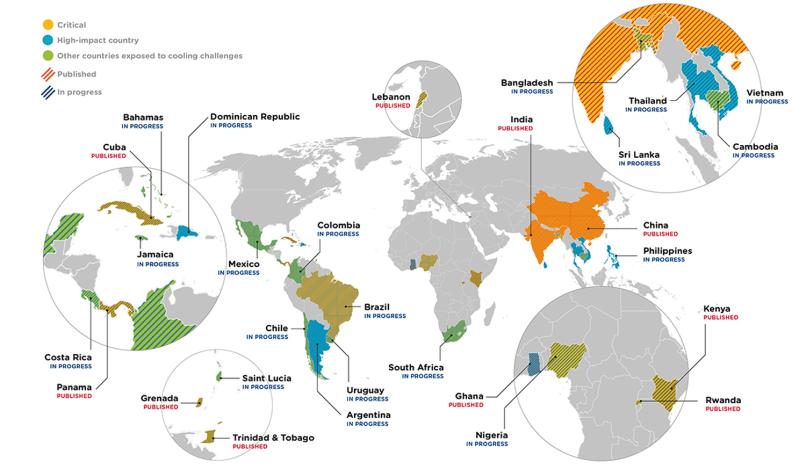Sustainable cooling policy progress
Key messages
- Access to sustainable cooling calls for better policies, enduring financial flows from the public and private sectors (including climate finance), and a community of practice able to leverage knowledge and existing resources to build partnerships and encourage more ambitious global commitments.
- The policy assessment for cooling across the Critical 9 [1] countries maps the existence of policies that enhance access to cooling; energy efficiency policies for active cooling and buildings and policies that encourage the use of sustainable cooling.
- Policies that enhance access to cooling remain limited, showing the need for more comprehensive energy plans.
2
of the Critical 9 countries have published their NCAP (China, India) while Bangladesh, Brazil, Indonesia, Pakistan, and Nigeria are currently developing them
1
of the Critical 9 countries has recognized cooling demand in electrification planning
5
of the Critical 9 countries have MEPS covering fans, refrigerators and ACs
Policies on access to cooling
Access to sustainable cooling solutions is a necessity for effective adaptation to climate change, especially for those areas and population groups that are most vulnerable to the effect of rising global temperatures. Cooling policies regulate or support the delivery of cooling solutions — active and passive — that are environmentally sustainable, efficient, affordable and commercially viable to meet cooling needs for food, nutrition and agriculture; health services; and human comfort and safety. Policies that enhance access to cooling are identified within national electrification strategies, data collection frameworks for cooling devices, and financial incentives or government programmes that bridge the affordability gap for cooling devices.
Across the Critical 9 countries, data quantifying access to sustainable cooling remain scarce, but information on policy signals is more readily available. The analysis shows, for example, that cooling demand is not generally reflected in electrification planning, with only Bangladesh having recognized it (Figure 3.1).
Financial incentives for the purchase of efficient on-grid refrigerators, air conditioners and fans are rarely available, and government programmes for off-grid devices could not be identified in any of the Critical 9 countries, nor were there financing mechanisms for such devices to support greater affordability, with anecdotal evidence suggesting that those that do exist are few and far between. Whether through an NCAP, National Energy Strategy, or Energy Efficiency strategy, price support and financial incentives are essential to increase the affordability of high-efficiency products, which would serve to meet the growing demand for cooling and manage its impact on power generation, transmission, and distribution planning. Off-grid, national electrification strategies could benefit from reflecting cooling needs, and government mechanisms for efficient air conditioners, fans and refrigerators can not only help meet cooling needs faster, but also ensure electrification progress is not slowed by growing energy needs for cooling, particularly in rural areas.
Among the Critical 9 countries, four have policies that support the expansion of passive cooling within their national energy policy, including Nigeria’s building code and India’s Cooling Action Plan. However, the implementation of such policies and plans is often lacking. Similarly, the policy tracking identifies opportunities for incorporating access to cooling. For instance, only three of the Critical 9 countries have NCAPs that consider improved access to cooling as a goal or target, meaning that there is an opportunity for the remaining countries to build it into their existing NCAPs or incorporate it from the beginning of the NCAP planning cycle.
Agricultural cold chains are recognized in policy in five of the Critical 9 countries but they are typically cited as a component of a sectoral development strategy. India’s Cooling Action Plan includes plans for integrating agricultural cold chains with sectoral strategies. Seven of the Critical 9 countries have at least one immunization plan or vaccine cold chain management overview publicly available, although with varying degrees of depth and recency.
Figure 3.1: Indicators for progress on access to cooling policies in the Critical 9 countries
Energy efficiency for cooling policies
The assessment of energy efficiency for cooling policies is well-documented as public information is available across the Critical 9 countries and from partner resources. Minimum energy performance standards (MEPS) and labels for cooling appliances, both mandatory and voluntary, identified in this assessment only cover on-grid products, implying a gap for the efficiency of devices with dedicated off-grid applications, which is particularly important for reaching isolated and rural populations.
Ensuring an optimal level for efficiency in MEPS and labels helps increase their efficacy, as well as the trust and support of the population for these instruments. If the energy-efficiency level of MEPS does not reflect the best available technologies, the efficacy of the policy and the affordability of high-efficiency units is likely to be suboptimal. Similar effects can occur when labels do not disclose relevant information to help consumers to choose high energy-performing products (HEPS). Therefore, it is essential that MEPS and labels recognize market changes and evolve accordingly.
Energy-efficiency policies for cooling technologies exist in all the Critical 9 countries but there are significant differences in their implementation and enforcement. MEPS for refrigerators, air conditioners and fans have yet to be adopted in Mozambique and Sudan, while Pakistan has MEPS only for fans, and Nigeria has neither refrigerator nor freezer MEPS. Similarly, Mozambique, Pakistan and Sudan have not adopted mandatory or voluntary energy-efficiency labelling.
Whether energy-efficiency policies are successful or not depends largely on the proper combination of information, regulation and incentives. [2] The enactment and enforcement of robust efficiency policies that cover refrigerants and compressors is key to avoid market dumping of inefficient and highly polluting products. Policymakers should not only set the policy framework but should also raise ambition and aim for improved product efficiency. For example, recent studies show that best-in class air conditioners available worldwide can achieve energy-efficiency ratios (EER) of 5.0–6.5 W/W. [3] [4] This is significantly above the minimum required efficiency ratios in most countries, including several countries in Africa, where they are below 3.0 W/W.
The Critical 9 countries have made insufficient progress or lack data on energy-efficiency regulations for imported air conditioners, fans and refrigerators (Figure 3.2).
Figure 3.2: Energy-efficient cooling policies in the Critical 9 countries
Climate change policies for cooling
Cooling and associated greenhouse gas (GHG) emissions have a substantial impact on countries’ abilities to meet their climate change goals. Delivering sustainable solutions is also critical for increased adaptation and resilience to the effects of climate change, which can be included in NDCs. From a mitigation perspective, cooling appliances are responsible for the emission of GHGs both indirectly through the consumption of grid electricity and directly from the release of refrigerant gases with high GWP, such as hydrochlorofluorocarbons (HCFCs) and hydrofluorocarbons (HFCs).
The Kigali Amendment to the Montreal Protocol, signed in October 2016, calls on countries to tackle both direct and indirect emissions from the cooling sector by drastically phasing down the use of HFCs as refrigerants while also improving the energy efficiency of cooling.
Among the Critical 9 countries, four refer to cooling in their updated NDCs submitted to the UN Framework Convention on Climate Change (UNFCCC): Bangladesh, China, India and Pakistan. The submission from Pakistan is the strongest; it lists the development of its NCAP as an adaptation action. Pakistan and Nigeria are working with the Clean Cooling Collaborative (CCC) to mainstream cooling in their NDC climate targets. [5] Five of the Critical 9 countries have ratified the Kigali Amendment – Bangladesh, China, India, Mozambique and Nigeria.
Figure 3.3: Cooling in national climate planning in the Critical 9 countries
National Cooling Action Plans
In 2021, NCAPs were published for Ghana, Grenada, Kenya and Lebanon. Several other countries continue to make progress on their plans in partnership with technical assistance from UNDP, UNEP, GIZ, CLASP, the UN Economic and Social Commission for Asia and the Pacific (ESCAP), and SEforALL. The Cool Coalition, [6] with support from coalition partners, released a holistic methodology for developing an NCAP, which provides guidance on how to plan for and make sustainable cooling for all a reality. Of the Critical 9 countries, two have already adopted an NCAP (China and India), while five more (Bangladesh, Brazil, Indonesia, Nigeria and Pakistan) are in the process of developing one, and two have yet to do so (Mozambique and Sudan).
Figure 3.4: Global status of National Cooling Action Plans in 2022

Sustainable cooling policy progress tracking
Note: 1) The Policy Tracker only maps policies in force (except for NCAP); 2) Partially refers to the existence of only one of the elements assessed in the policy (e.g., one type of product covered in the policy or only one sector targeted). For example, China has the largest ESCO market [7] but it does not target the residential sector, [8] hence it is rated as Partially; 3) The full policy tracking database contains additional information by policy.
Notes and references
[1] Critical 9 refers to the top nine high-impact countries for access to cooling. They are: Bangladesh, Brazil, China, India, Indonesia, Mozambique, Nigeria, Pakistan and Sudan.
[2] The Future of Cooling (2018). IEA. Link.
[3] The energy-efficiency ratio (EER) is used to measure energy-efficiency performance for air conditioners. According to ISO 5151:2017, it is defined as the total cooling capacity divided by the device’s effective power input under any set of rating conditions). The higher the EER, the more efficient the air conditioner.
[4] Efficiency for RACs. N. Shah, W.Y. Park, Trends in best-in-class energy-efficient technologies for room air conditioners (2021). Link.
[5] https://coolcoalition.org/k-cep-supports-10-countries-to-enhance-ndcs-with-new-work-on-efficient-climate-friendly-cooling/
[6] The Cool Coalition is a global multi-stakeholder network that connects a wide range of key actors from government, cities, international organizations, business, finance, academia, and civil society groups to facilitate knowledge exchange, advocacy, and joint action towards a rapid global transition to efficient and climate-friendly cooling. The Cool Coalition is now working with over 100 partners, including 23 countries.
[7] Evolving Energy Service Companies in China. IEA, August 2021. Link.
[8] Regulatory Indicators for Sustainable Energy. ESMAP. Link.


